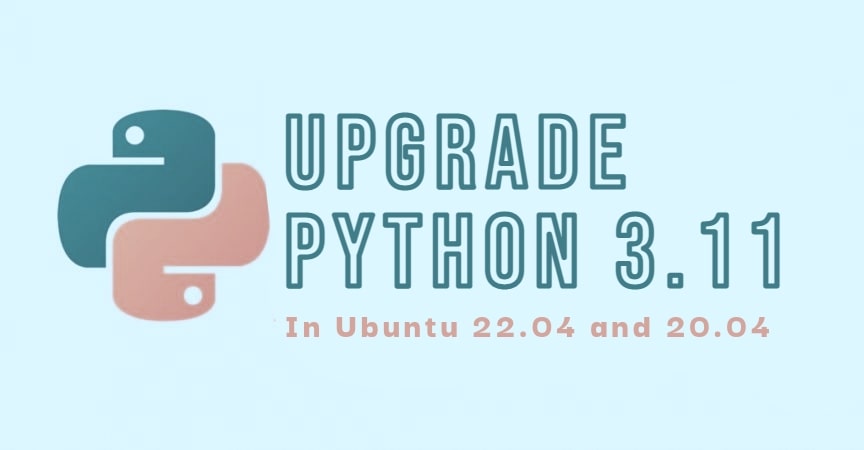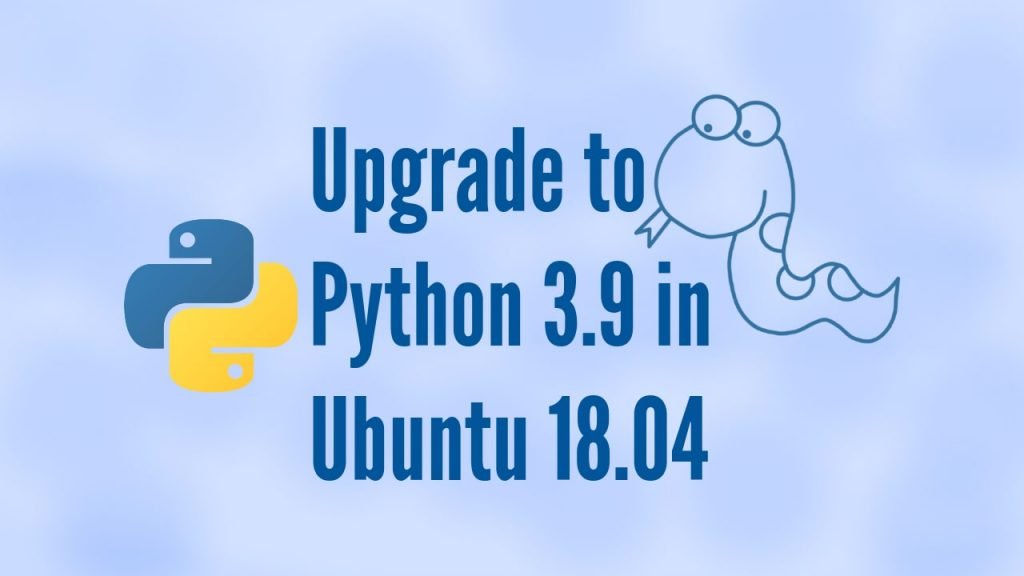- Upgrade Python to latest version (3.10) on Ubuntu Linux
- Updating Python to the latest version
- Step 1: Check if Python3.10 is available for install
- Step 2: Install Python 3.10
- Step 3: Set Python 3.10 as default
- Fix pip and disutils errors
- Fix Python3-apt
- Install pip & distutils
- Fix pip-env errors when using venv
- Extra
- How to upgrade to Python 3.11 on Ubuntu 20.04 and 22.04 LTS
- Install Python 3.11
- Step 1: Add the repository and update
- Step 2: Install the Python 3.11 package using apt-get
- Step 3: Add Python 3.10 & Python 3.11 to update-alternatives
- Step 4: Update Python 3 for point to Python 3.11
- Step 5: Test the version of python
- How to upgrade to Python 3.9.0 on Ubuntu 18.04 LTS
- Install Python 3.9.0
- Step 1: Add the repository and update
- Step 2: Install the Python 3.9.0 package using apt-get
- Step 3: Add Python 3.6 & Python 3.9 to update-alternatives
- Step 4: Update Python 3 for point to Python 3.9
- Step 5: Test the version of python
Upgrade Python to latest version (3.10) on Ubuntu Linux
Linux systems come with Python install by default, but, they are usually not the latest. Python also cannot be updated by a typical apt upgrade command as well.
To check the version of Python installed on your system run
python keyword is used for Python 2.x versions which has been deprecated
- Update Python to the latest version
- Fix pip & other Python related issues
- While doing the above two, ensure your Ubuntu which is heavily dependent on Python does not break
Updating Python to the latest version
Ubuntu’s default repositories do not contain the latest version of Python, but an open source repository named deadsnakes does.
Python3.10 is not officially available on Ubuntu 20.04, ensure you backup your system before upgrading.
Step 1: Check if Python3.10 is available for install
sudo add-apt-repository ppa:deadsnakes/ppa sudo apt update Check if Python 3.10 is available by running
This will produce the below result, if you see python3.10 it means you can install it
Step 2: Install Python 3.10
Now you can install Python 3.10 by running
sudo apt install python3.10 Now though Python 3.10 is installed, if you check the version of your python by running python3 —version you will still see an older version. This is because you have two versions of Python installed and you need to choose Python 3.10 as the default.
Step 3: Set Python 3.10 as default
Steps beyond here are tested on Ubuntu 20.04 in VM & WSL2, but are experimental , proceed at your own risk.
Changing the default alternatives for Python will break your Gnome terminal. To avoid this, you need to edit the gnome-terminal configuration file.
Open the terminal and run:
sudo nano /usr/bin/gnome-terminal In first line, change #!/usr/bin/python3 to #!/usr/bin/python3.8 . Press Ctrl +X followed by enter to save and exit.
Then save and close the file.
Next, update the default Python by adding both versions to an alternatives by running the below
sudo update-alternatives --install /usr/bin/python3 python3 /usr/bin/python3.9 Now run
sudo update-alternatives --config python3 Choose the selection corresponding to Python3.10 (if not selected by default).
Now run python3 —version again and you should see the latest Python as the output.
Fix pip and disutils errors
Installing the new version of Python will break pip as the distutils for Python3.10 is not installed yet.
Fix Python3-apt
Running pip in terminal will not work, as the current pip is not compatible with Python3.10 and python3-apt will be broken, that will generate an error like
Traceback (most recent call last): File "/usr/lib/command-not-found", line 28, in <module> from CommandNotFound import CommandNotFound File "/usr/lib/python3/dist-packages/CommandNotFound/CommandNotFound.py", line 19, in <module> from CommandNotFound.db.db import SqliteDatabase File "/usr/lib/python3/dist-packages/CommandNotFound/db/db.py", line 5, in <module> import apt_pkg ModuleNotFoundError: No module named 'apt_pkg' To fix this first remove the current version of python3-apt by running
sudo apt remove --purge python3-apt DO NOT RUN sudo apt autoremove as it will remove several packages that are required. This may break your system if you’re using GUI, if you’re on WSL2 you can proceed.
Finally, reinstall python3-apt by running
sudo apt install python3-apt Install pip & distutils
Running pip will still throw an error pip: command not found . We need to install the latest version of pip compatible with Python 3.10.
Also, if try to manually install the latest version of pip, it will throw an error like
ImportError: cannot import name 'sysconfig' from 'distutils' (/usr/lib/python3.10/distutils/__init__.py) Or you might also see an error stating No module named ‘distutils.util’ . This is because the distutils module is not installed yet, to install run the below command
sudo apt install python3.10-distutils Now you can install pip by running
curl https://bootstrap.pypa.io/get-pip.py -o get-pip.py sudo python3.10 get-pip.py If you get an error like bash: curl: command not found then you need to install curl first by running sudo apt install curl
Now you can run pip and you should see the output of pip —version
Fix pip-env errors when using venv
When you try to create a new virtual environment using python -m venv env , you may into the following error.
Error: Command -Imensurepip--upgrade--default-pipYou can fix this by reinstalling venv by running sudo apt install python3.10-venv All should be done now. It is complicated, but this is how you update Python to latest version.
Extra
If you have oh-my-zsh installed, you can avoid typing out python3 by running
Now you can run your files with py or python .
How to upgrade to Python 3.11 on Ubuntu 20.04 and 22.04 LTS
In this article, we will upgrade to Python 3.11 and configure it as the default version of Python in Ubuntu 20.04 and 22.04 LTS.
So let’s start with checking the currently installed version of Python on your system.
As seen in the image above, my currently installed Python version is 3.10 but yours may differ.
Install Python 3.11
Follow the simple steps to install and configure Python 3.11
Step 1: Add the repository and update
The latest Python 3.11 is not available in Ubuntu’s default repositories. So, we have to add an additional repository. On launchpad repository named deadsnakes is available for Python Packages.
Add the deadsnakes repository using the below commands.
sudo add-apt-repository ppa:deadsnakes/ppa sudo apt-get updateUpdate the package list using the below command.
Verify the updated Python packages list using this command.
As seen in the image above, Now we have Python 3.11 available for installation.
Step 2: Install the Python 3.11 package using apt-get
install Python 3.11 by using the below command :
sudo apt-get install python3.11Step 3: Add Python 3.10 & Python 3.11 to update-alternatives
Add both old and new versions of Python to Update Alternatives.
sudo update-alternatives --install /usr/bin/python3 python3 /usr/bin/python3.10 1 sudo update-alternatives --install /usr/bin/python3 python3 /usr/bin/python3.11 2Step 4: Update Python 3 for point to Python 3.11
By default, Python 3 is pointed to Python 3.10. That means when we run python3 it will execute as python 3.10 but we want to execute this as python 3.11.
Type this command to configure python3:
sudo update-alternatives --config python3You should get the above output. Now type 2 and hit enter for Python 3.11. Remember the selected number may differ so choose the selection number which is for Python 3.11.
Step 5: Test the version of python
Finally, test the current version of Python by typing this :
You should get Python 3.11 as an output.
In this article, we learn how to upgrade Python to the latest version which is 3.11 in Ubuntu 20.04 and 22.04 LTS.
How to upgrade to Python 3.9.0 on Ubuntu 18.04 LTS
In this article, we will upgrade to python 3.9.0 and configure it as the default version of python in Ubuntu 18.04 LTS.
The current stable version of python released on 14 Oct. 2020. Many ubuntu users are facing problems during upgrading python to the latest version. Python 3.8 available as default when we install Ubuntu 18.04 LTS. Python 3.9.0 is not available in default Ubuntu 18.04 repositories.
So let’s start with checking the currently installed version of Python on your system.
As seen in the image above, my currently installed Python version is 3.6.9 but yours may differ.
Install Python 3.9.0
Follow the simple steps to install and configure Python 3.9.0
Step 1: Add the repository and update
Latest Python 3.9 not available in Ubuntu’s default repositories. So, we have to add an additional repository. On launchpad repository named deadsnakes is available for Python Packages.
Add the deadsnakes repository using the below commands.
sudo add-apt-repository ppa:deadsnakes/ppa sudo apt-get updateUpdate the package list using the below command.
Verify the updated Python packages list using this command.
As seen in the image above, Now we have Python 3.9.0 available for installation.
Step 2: Install the Python 3.9.0 package using apt-get
install Python 3.9.0 by using the below command :
sudo apt-get install python3.9Step 3: Add Python 3.6 & Python 3.9 to update-alternatives
Add both old and new versions of Python to Update Alternatives.
sudo update-alternatives --install /usr/bin/python3 python3 /usr/bin/python3.6 1 sudo update-alternatives --install /usr/bin/python3 python3 /usr/bin/python3.9 2Step 4: Update Python 3 for point to Python 3.9
By default, Python 3 is pointed to Python 3.6. That means when we run python3 it will execute as python3.6 but we want to execute this as python3.9.
Type this command to configure python3:
sudo update-alternatives --config python3You should get the above output. Now type 2 and hit enter for Python 3.9. Remember the selected number may differ so choose the selection number which is for Python 3.9.
Step 5: Test the version of python
Finally, test the current version of python by typing this :
You should get Python 3.9 as output.
In this article, we learn how to upgrade python to the latest version that is 3.9.0 in Ubuntu 18.10.


